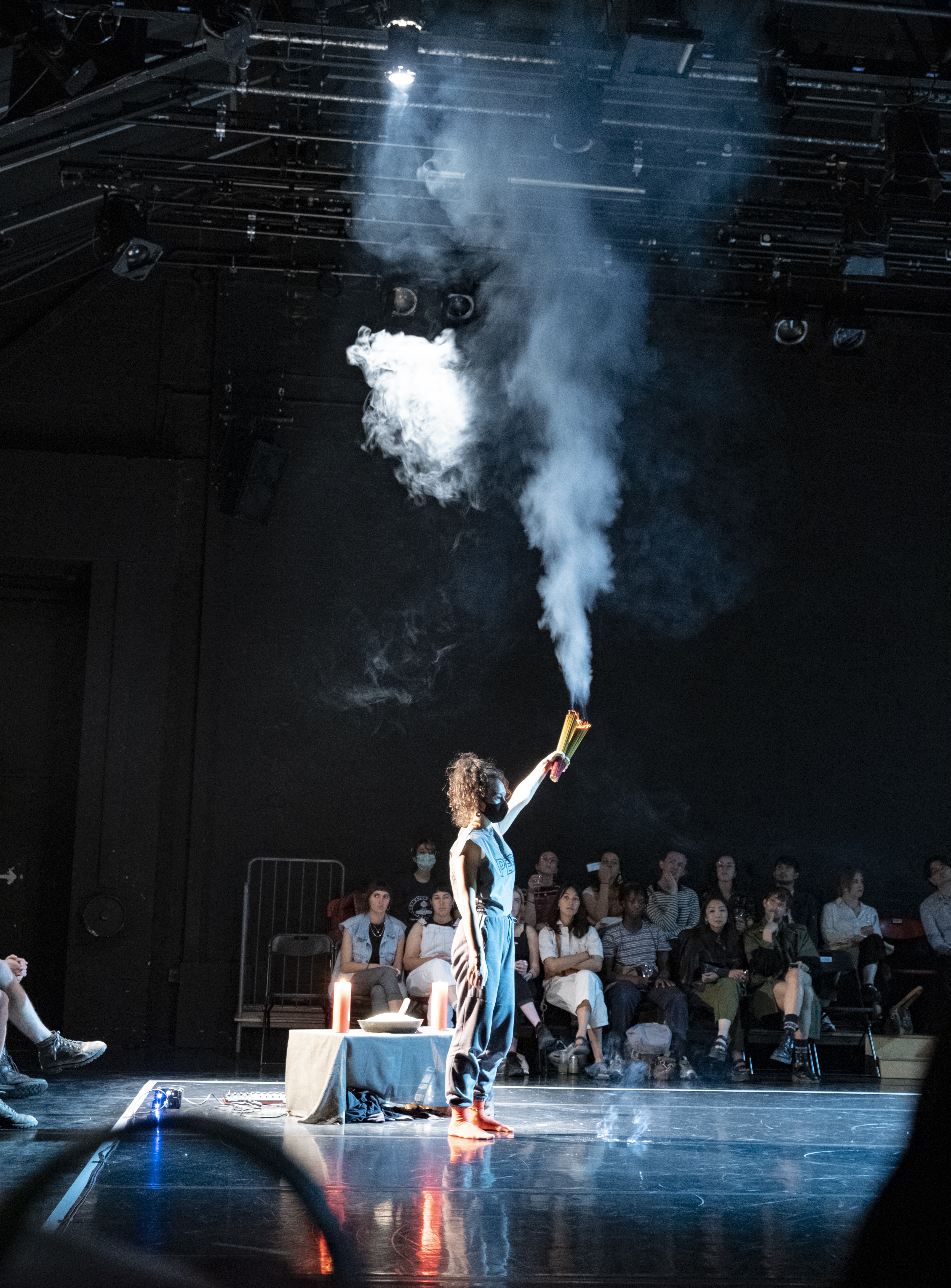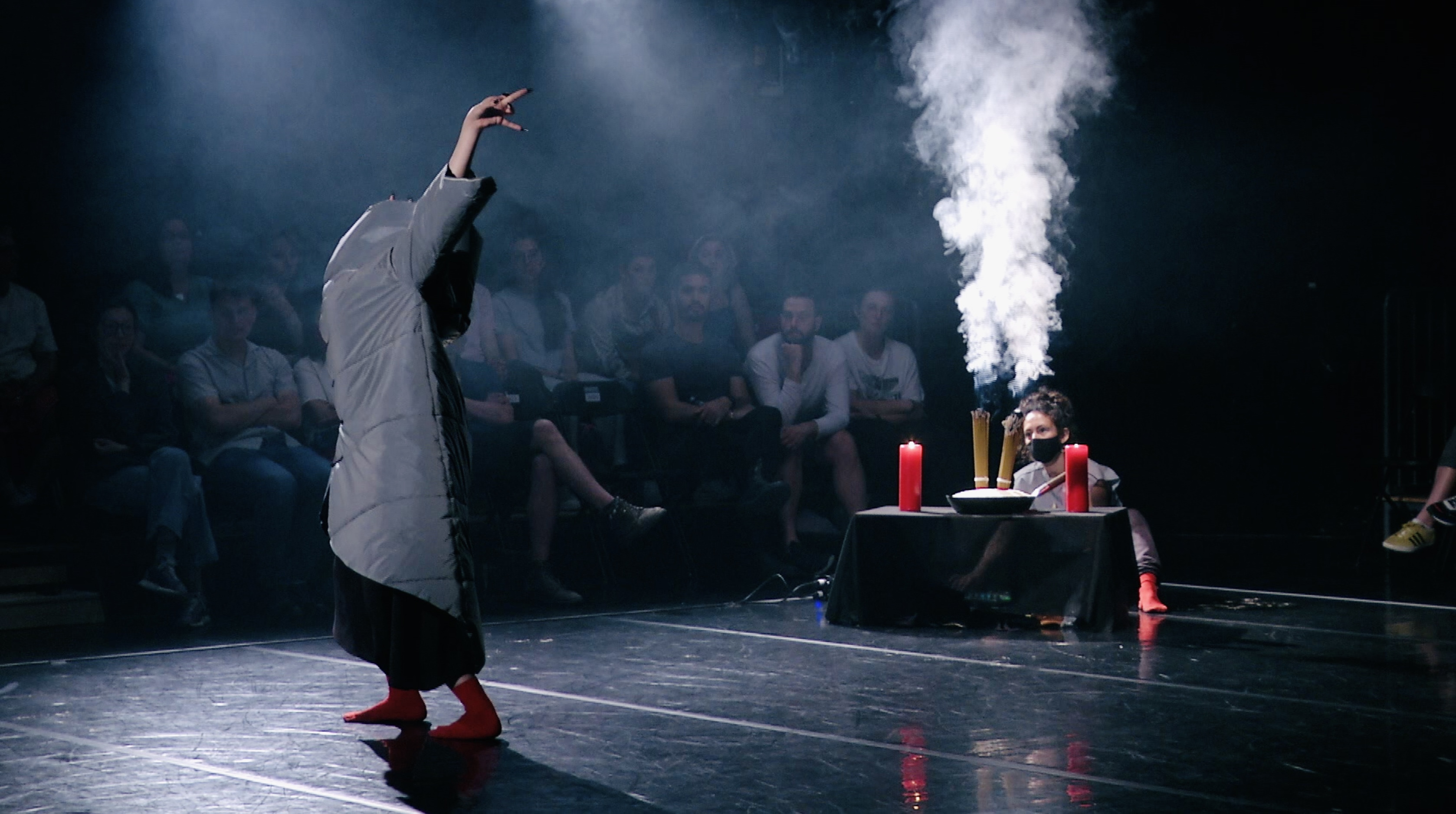Words by Sarah Lapinsky.
With the sound of coffee grinding and smoothies blending in the background, Monica Tolia (they/she) and I discussed their interdisciplinary practice, creative process and new work, a snake in the house means the family will never want, that premiered during the final week of Resolution 2022 at The Place.
After settling in with our smoothie and matcha latte, Tolia started by asking me about my experience watching a video of the piece as I was unable to attend the performance live. Suddenly shy, I replied that even through the screen, I could feel my senses engaged while watching the strong, snake-like movement, imagining the smell of burning incense bundles wafting about the stage and listening to the voicenote spoken in Chinese by Tolia’s mother transform into futuristic electronic music. We talked about the details of the design elements within the piece and the overall effect of the work. Tolia sums it up when they note:
“I’m not interested in making the kind of art the audience might expect… rather I’m interested in the visceral sensory experiences of destabilised home(lands) & how it’s shaped not only who I am, but a new generation who are breaking silence on these topics.”
This segued us nicely into my first question for Tolia about where the inspiration or spark behind the piece came from. After taking a moment to ponder their response, Tolia explained that there was not as much a decision to make a work as there was a “catalyst” for a process, “a lifetime of feelings coming to a head” spurred by current events and growing concerns for the future that pushed them to “exit the territory of staying silent.”
Tolia further explained this formerly ingrained pressure around silence by introducing me to the concept of Hek Fu åƒè‹¦, which translates to “eating bitterness”: the cultural value of holding in hardship and grief. Tolia explained that this was originally intended to conserve collective well-being, but they went on to interrogate how migration and displacement affect this cultural norm. When put into a new context, is “eating bitterness” understood as it is intended or is it taken as passive acceptance of certain treatment or behavior? This reflection amidst growing anti-Asian racism and its intersection with the gender-based violence of recent years prompted Tolia’s conversations with their mother and set the work in motion.
We spent some time discussing the voicenote at the beginning of the piece, and how it sets up the ideas of alienation and cultural misunderstandings while also leaving “breadcrumbs” for the audience to pick up on by mentioning specific years of note. Tolia explained that their mother is speaking the minority dialect of Toisan, a language that was formerly the lingua franca of North American Chinatowns until the 1980s that is now only spoken by the elder diaspora generations and direct descendants from the region of the dialect’s origin in Taishan (China). I found this very interesting as it creates yet another layer of alienation within the theme of cultural misunderstandings while bringing a marginal history into the present. Tolia explained how the script of the voicenote co-written with their mother, required contributions from a community of elders to translate the writing into Toisan as it does not have its own standardised writing form. Tolia explains “it’s a language with class implications that exists only on the tongue.” This moment of the process demonstrates one of the themes of the work in recognizing previous generations while supporting the transformation as it happens. This dialect holds history in it, tracing migration and movement through time and space with the rippling effects it created. Tolia pointed out that they are:
“More interested in the contexts of what hasn’t been considered relevant & why. In my work, I’m pointing to lesser known histories, ways of being, & the messy tenderness of mutual dependency that allows us to do more than just survive.”
In interviewing Tolia, I was intrigued to hear that the title of the piece was also a shift from the original saying ‘a snake in the house means the family will never starve.’ Tolia changed ‘starve’ to ‘want’ in recognition of the intergenerational transformation from focusing on basic needs to the “desire/dream in all its expansiveness.” Somehow, Tolia can seamlessly merge the past, present and future with a single word or a simple gesture.
Tolia’s work in creating the costuming is another tradition passed down from their mother and grandmother who taught them how to sew and make clothing. Among the costume pieces was an embroidered, reflective puffer coat reminiscent of a snake skin that the second performer, Ting-ning Wen, moves with and gorgeously emerges from. She wears a face mask with a long snake tongue attached to the front that follows her as she slithers into the stage floor. Tolia related how Ting-ning described her role as “a snake being born into a foreign place, trying to become human, only to unlearn and embrace what [she] always was: a snake.”
The prominent image of the snake itself is rooted in Chinese culture as a symbol of prosperity and good omens. Tolia and I hit an interesting point in our conversation when I brought up how many people (including myself) are afraid of snakes perhaps because we do not have a lot of experience with them or find their movement unpredictable. Where one person sees goodness, another may see danger. Our interview beautifully demonstrated what Tolia was initiating with the work: the recognition of perspective and reinterpretation dependent upon context and culture.

Expanding the idea of introducing different viewpoints, Tolia was driven to apply for this year of Resolution as the final week of the festival would feature works set in the round. Tolia normally performs their work in galleries or club settings where they can “be amongst and in proximity” to the audience and emphasize the experiential aspects of their work; performing in the round seemed like a good opportunity to reach the theatre audience in this way. As with any experience in the round, the audience will inevitably have moments of the work where the action is not visible. In the video I saw, a notable moment of unseeing or invisibility occurred as Tolia knelt down to light two candles and the bundles of incense in a ceremonious way before parading the smoke around the perimeter of the stage. This striking juxtaposition between what is visible, emphasized or reflected thoughtfully illustrates the complexity of cultural hybridity both in oneself and a greater community. Referencing yellow peril rhetoric, the effects of COVID-19 & the violence it has created for ESEA (East and Southeast Asian) communities in the West, Tolia is remarkably able to make these political statements in the work while preserving the beauty and creativity of the form. Even more impressive, the beauty of the work only strengthens the speaking of truth.
What struck me most about speaking with Tolia and learning about the work is how perfectly the piece and the process melded together. The process directly engages with the ideas it is exploring by acknowledging the older generations, building community and sharing it all in a theatre in the UK. The piece holds all of the complex history of the dialect, the choreographer’s auto-fictitious symbolism and ideas of the future while creating it all in the moment of the performance. Breaking the silence with conversation, I am excited to have had the opportunity to join this artist in their work and look forward to what they create next.
More information about Monica Tolia can be found at:
Link to Website: http://www.monicatolia.com/
